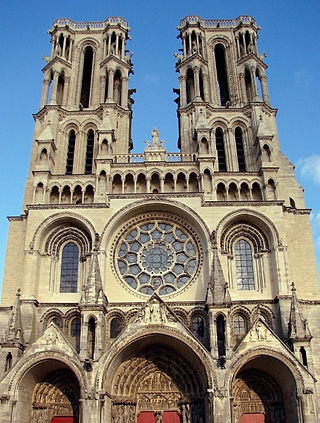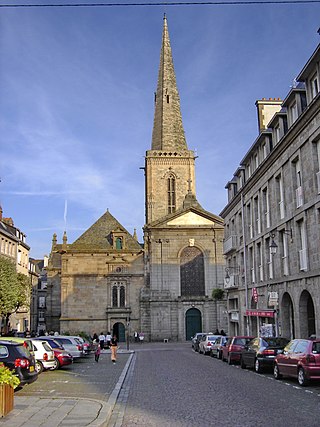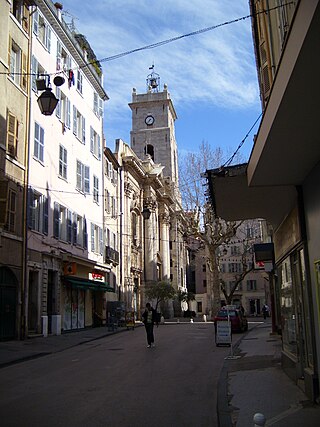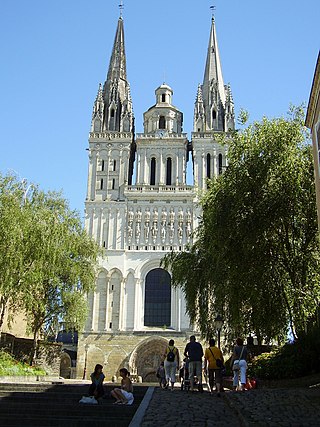
The Archdiocese of Paris is a Latin Church ecclesiastical jurisdiction or archdiocese of the Catholic Church in France. It is one of twenty-three archdioceses in France. The original diocese is traditionally thought to have been created in the 3rd century by St. Denis and corresponded with the Civitas Parisiorum; it was elevated to an archdiocese on October 20, 1622. Before that date the bishops were suffragan to the archbishops of Sens.

The Roman Catholic Archdiocese of Bourges is an archdiocese of the Latin Church of the Roman Catholic Church in France. The Archdiocese comprises the departements of Cher and Indre in the Region of Val de Loire. Bourges Cathedral stands in the city of Bourges in the department of Cher. Although this is still titled as an Archdiocese, it ceased as a metropolitan see in 2002 and is now a suffragan in the ecclesiastical province of Tours.
The Archbishopric of Vienne, named after its episcopal seat in Vienne in the Isère département of southern France, was a metropolitan Roman Catholic archdiocese. It is now part of the Archdiocese of Lyon.

The Diocese of Périgueux and Sarlat is a Latin Church ecclesiastical territory or diocese of the Catholic Church in France. Its episcopal see is Périgueux, in the département of Dordogne, in the région of Aquitaine. The Diocese of Périgueux is a suffragan diocese in the ecclesiastical province of the metropolitan Archdiocese of Bordeaux. The current bishop is Philippe Mousset, who was appointed in 2014.

The Bishopric of Lodève is a former Roman Catholic diocese in southern France. Its episcopal see was located in Lodève, in the modern department of Hérault. Its territory is now part of the archdiocese of Montpellier.

The diocese of Laon in the present-day département of Aisne, was a Catholic diocese for around 1300 years, up to the French Revolution. Its seat was in Laon, France, with the Laon Cathedral. From early in the 13th century, the bishop of Laon was a Pair de France, among the elite.

The former Catholic diocese of Mirepoix, in south-west France, was created in 1317 by Pope John XXII from the diocese of Pamiers. It existed until the French Revolution, and was suffragan of the Archbishop of Toulouse. Its see was Mirepoix, Ariège.

The former French Catholic Diocese of Noyon lay in the north-east of France, around Noyon. It was formed when Saint Medardus moved the seat of the bishopric at Vermandois to Noyon, in the sixth century. For four centuries it was united with the bishopric of Tournai as the Diocese of Noyon–Tournai. Then in the twelfth century it was again independent, and the bishop of Noyon became a pairie-comté of France.

The former French Catholic diocese of Rieux existed from 1317 until the French Revolution. It was based at Rieux-Volvestre, south-west France, in the modern department of Haute-Garonne.

The former Breton and French diocese of Tréguier existed in Lower Brittany from about the sixth century, or later, to the French Revolution. Its see was at Tréguier, in the modern department of Côtes-d'Armor.

The former Breton and French Catholic Diocese of Saint-Malo existed from at least the 7th century until the French Revolution. Its seat was at Aleth up to some point in the 12th century, when it moved to Saint-Malo. Its territory extended over some of the modern departments of Ille-et-Vilaine, Côtes-d'Armor, and Morbihan. Until the 860s, it was often termed the bishopric of Poutrocoet.

The former French Catholic diocese of Saint-Omer existed from 1559 until the French Revolution. Its see at Saint-Omer, in the modern department of Pas-de-Calais, was created as a reaction to the destruction of the see of Thérouanne, by military action in the wars of the Emperor Charles V. It then became a suffragan of the Archdiocese of Cambrai in 1559.

The former French Catholic diocese of Senez existed from around the fifth or sixth century, until the French Revolution. Its see was at Senez, in southern France, in the modern department of Alpes-de-Haute-Provence. After the Concordat of 1801 the territory of the diocese was added to that of the diocese of Digne.

The former French Roman Catholic Diocese of Toulon existed until the Concordat of 1801. Its seat was in Toulon.

The Roman Catholic Diocese of Béziers was situated in France. It is no longer an independent diocese, and is part of the Diocese of Montpellier.

The Catholic Diocese of Castres, in Southern France, was created in 1317 from the diocese of Albi. It was suppressed at the time of the French Revolution, under the Concordat of 1801. Its territory returned to the archdiocese of Albi.

The former Catholic Diocese of Lectoure was in south-west France. It existed from the fourth century until the time of the French Revolution, when it was suppressed under the Concordat of 1801. Its see was Lectoure Cathedral. Lectoure is now a commune of Gers.

The Diocese of Nîmes is a diocese of the Latin Church of the Catholic Church in France. The diocese comprises all of the department of Gard. It is a suffragan of the Diocese of Avignon.

The Roman Catholic Diocese of Lescar, in south-western France, was founded in the fifth century, and continued until 1790. It was originally part of the Province of Novempopulania, and Lescar held the seventh place among the cities. Its see was the Cathedral of the Assumption in Lescar, begun in 1120; the crypt of the cathedral was also the mausoleum of the family of Albret in the 16th century.

The Roman Catholic Diocese of Angers is a diocese of the Latin Church of the Roman Catholic Church in France. The episcopal see is located in Angers Cathedral in the city of Angers. The diocese extends over the entire department of Maine-et-Loire.



















